Why New Home Electrical Upgrades Matter More Than Ever
New home electrical upgrades are essential for safety, convenience, and future-proofing your investment. Here’s what you need to know:
Most Important Upgrades:
– 200-amp service panel (minimum for modern homes)
– GFCI and AFCI outlets in all required areas
– Smart home pre-wiring (Cat6, structured media panel)
– EV charging preparation (240V garage circuit)
– Whole-house surge protection
– LED-compatible lighting circuits
– Additional outlets (every 12 feet minimum)
The average U.S. household uses 400% more electricity today than in the 1960s. Modern homes demand more power for smart devices, electric vehicles, and energy-efficient appliances.
Why do this during construction? Adding outlets and circuits costs 10x more after drywall goes up. The National Electrical Code updates every three years with stricter safety requirements – getting ahead of these changes protects your investment.
I’m Jesse Burnett, Master Electrician and founder of Dr. Electric CSRA, with over 1,200 completed jobs spanning residential new construction, panel upgrades, and smart home installations. Through my experience with new home electrical upgrades, I’ve seen how proper planning during construction saves homeowners thousands while delivering decades of reliable service.
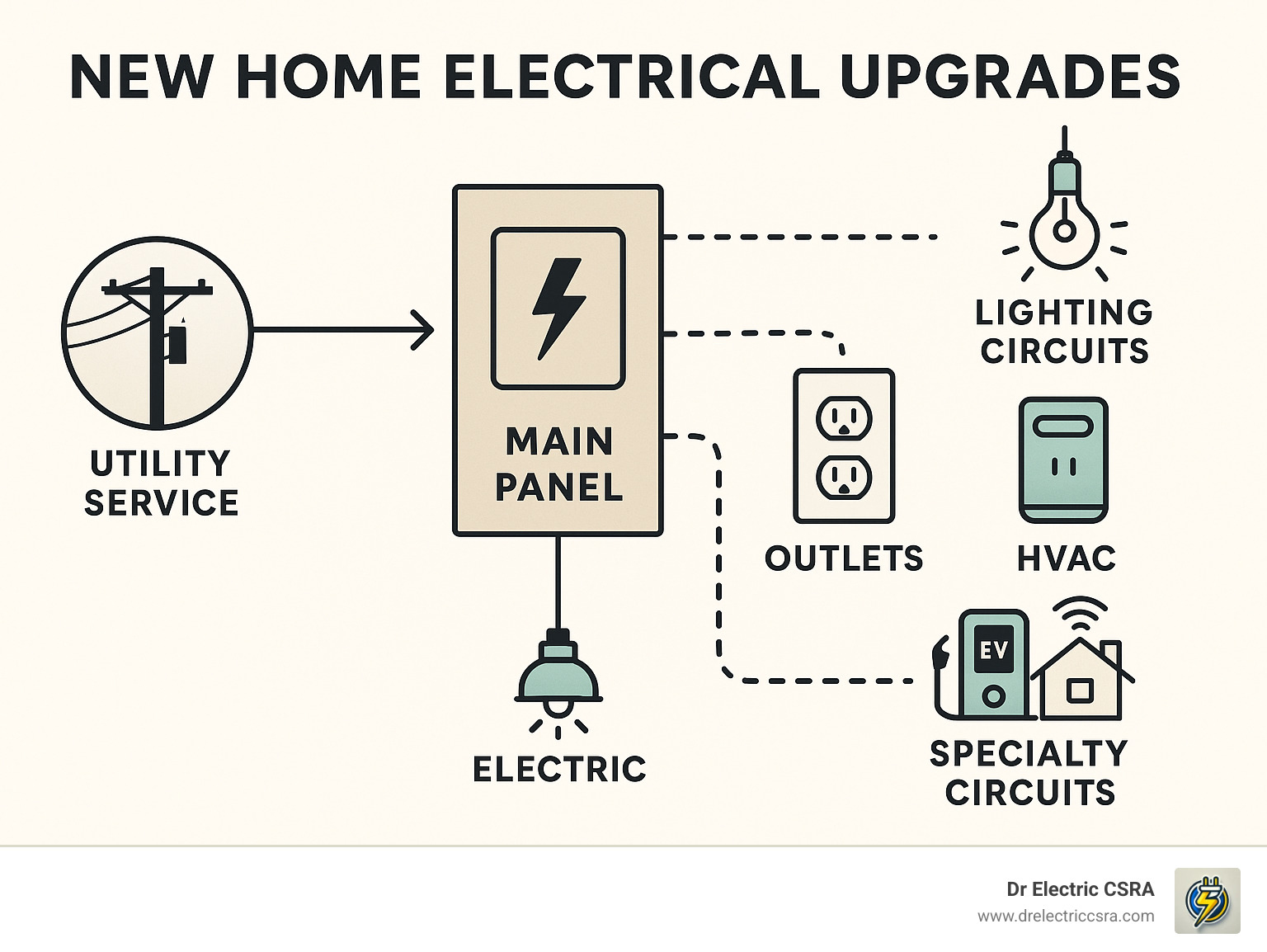
Easy new home electrical upgrades glossary:
– 100 amp panel upgrade
– cost of new electrical panel
– new electrical panel upgrade
1. Power Planning: Service Panel & Capacity
Think of your electrical panel as the heart of your home – it needs to be strong enough to pump power to every corner without breaking a sweat. Getting this right during new home electrical upgrades is like buying the right size shoes for a growing teenager. Go too small, and you’ll be shopping again soon.
Most homes built before 2010 came with 100-amp panels, which worked fine when our biggest electrical worry was running the dishwasher and dryer at the same time. Today’s homes need much more capacity.
Modern electrical panels typically start at 200 amps for standard homes, with luxury homes often needing 400 amps or more. Your central air conditioning pulls 30-50 amps. That electric range in your dream kitchen? Another 40-50 amps. Add your electric dryer at 30 amps, and you’re already pushing the limits of an older system.
Now add modern demands. An EV charger needs 40-50 amps for Level 2 charging. That hot tub you’ve been eyeing pulls 40-60 amps. Even your electric water heater demands 20-30 amps.
| Panel Size | Best For | Typical Loads |
|---|---|---|
| 100 Amp | Small homes, minimal electrical needs | Basic appliances, lighting |
| 200 Amp | Standard modern homes | Full appliances, AC, some smart home features |
| 400 Amp | Large homes, high electrical demands | Everything above plus EV charging, hot tubs, extensive smart systems |
Circuit breakers must be derated to 80% for continuous loads. That means your 60-amp breaker actually provides only 48 amps of reliable, continuous power.
Panel longevity is another factor. A well-maintained electrical panel serves your family for 25-40 years. Since you’re building new, spending more now for a properly sized panel beats the headache and expense of upgrading in ten years.
Latest research on household energy growth shows we’re not slowing down our electrical appetite anytime soon.
The beauty of getting this right during construction is cost. Adding dedicated circuits during the rough-in phase costs a fraction of what you’d pay later. We’ve seen homeowners spend $15,000 on electrical upgrades that would have cost $3,000 during initial construction.
Need help sizing your panel correctly? Our Upgrade Electrical services ensure your new home can handle whatever the future throws at it.
Right-Sizing Your Panel for new home electrical upgrades
Future-proofing your electrical system means thinking ahead. Electric vehicles are the perfect example. Maybe you’re driving a gas car today, but Level 2 EV charging at 240 volts can fill up an electric vehicle overnight. Installing the infrastructure now adds serious value and saves thousands later.
Hot tubs and spas require dedicated 40-60 amp circuits that need to be planned from the beginning. HVAC loads keep growing too. Modern heat pumps and high-efficiency air conditioning systems often need larger circuits.
Solar back-feed capability is becoming essential, even if you’re not installing panels immediately. Battery storage systems for whole-home backup are exploding in popularity and require substantial electrical capacity.
Future Expansion Without Service Upgrade
Smart breakers monitor your electrical usage in real-time and can automatically shed non-essential loads during peak demand periods. Load-shedding devices automatically manage high-draw appliances – your water heater might pause when your EV starts charging.
Power-smart appliances reduce your overall electrical demand through improved efficiency, creating room in your electrical budget for other additions without requiring a service upgrade.
2. Outlet Overload: Receptacle Strategy & Placement
Here’s a frustrating scenario: homeowners moving into their beautiful new house, only to find they’re constantly hunting for outlets or dealing with extension cords. The 12-foot rule from the National Electrical Code is just the bare minimum.
Think about your daily routine. You’re charging phones, tablets, and laptops. You’ve got coffee makers, air fryers, and stand mixers on the counter. That’s why smart new home electrical upgrades start with strategic outlet planning during construction.
Floor outlets are game-changers for living rooms and bedrooms. These flush-mounted receptacles let you power table lamps exactly where you want them, without cords stretching across walkways. Map out your furniture placement first, then position outlets where they’ll actually be useful.
In kitchens, countertop pop-up outlets keep your workspace clean while providing power exactly where you need it. These recessed units disappear when not in use but pop up to handle your blender, mixer, or phone charger.
Exterior receptacles on every side of your home make holiday decorating a breeze and provide convenient power for lawn equipment and outdoor entertaining.
USB-C combo outlets are becoming essential. These hybrid receptacles give you traditional plug-in power plus built-in USB charging ports.
Half-hot switch legs have one receptacle controlled by a wall switch (perfect for lamps) while the other stays powered all the time for appliances.
Our Residential Electrical team works with homeowners to create outlet layouts that actually match how families live, not just what the code requires.

Specialty Outlets Every Builder Should Add
Some outlets aren’t just conveniences – they’re literal lifesavers. Modern electrical codes require specific safety outlets because they prevent electrocution, fires, and accidents.
GFCI outlets are your first line of defense against electrical shock. These smart devices monitor electrical current and shut off power in milliseconds if they detect a problem. The vast majority of home outlets need GFCI protection, especially in bathrooms, kitchens, garages, basements, and anywhere moisture might be present.
AFCI outlets tackle electrical fires caused by damaged wiring or loose connections. These Arc Fault Circuit Interrupters detect the electrical signature of dangerous arcing and cut power before a fire can start.
Tamper-resistant receptacles are mandatory in new homes. These outlets have built-in shutters that prevent children from sticking objects into the slots.
Even if you don’t own an electric vehicle today, installing a 240V EV outlet in your garage is one of the smartest investments you can make. Electric vehicles aren’t going anywhere, and having the proper outlet already installed adds significant value while saving thousands in future installation costs.
Where New Home Electrical Upgrades Save the Most Money
The rough-in stage is your golden opportunity to get electrical work done affordably. Once drywall goes up, every additional outlet or circuit becomes a major project.
During construction, walls are open and accessible. The labor cost for adding an outlet during rough-in might be $50-75. That same outlet after construction could cost $300-500.
Smurf tubing is flexible conduit installed inside walls during construction, creating pathways for future wire runs. Want to add a ceiling fan later? The pathway is already there – no wall damage required.
Electrical work during construction costs about one-tenth what it costs during renovation. Plan generously now, and you’ll thank yourself for decades to come.
3. Smart & Future-Proof Tech Hub
Your new home needs to be a technology command center, not just a place with Wi-Fi. Whole-home Wi-Fi infrastructure forms the foundation, but strategic wired connections provide the reliable backbone that keeps your mesh networks humming.
Cat6 or Cat7 ethernet cables should run to every room where you might work, stream, or game. These cables deliver faster, more stable connections than wireless can match.
The structured media panel acts like mission control for your entire smart home. Instead of having cables and devices scattered throughout the house, everything connects to one organized hub.
Power over Ethernet (PoE) cameras represent smart planning. One cable delivers both power and data, which means cleaner installation and better reliability.
Voice-control switches and smart thermostats transform how you interact with your home. Programmable thermostats alone can slash 10% off your heating and cooling costs through intelligent scheduling.
Professional Surge Protection protects this entire investment – because replacing a fried smart panel costs infinitely more than preventing the damage.
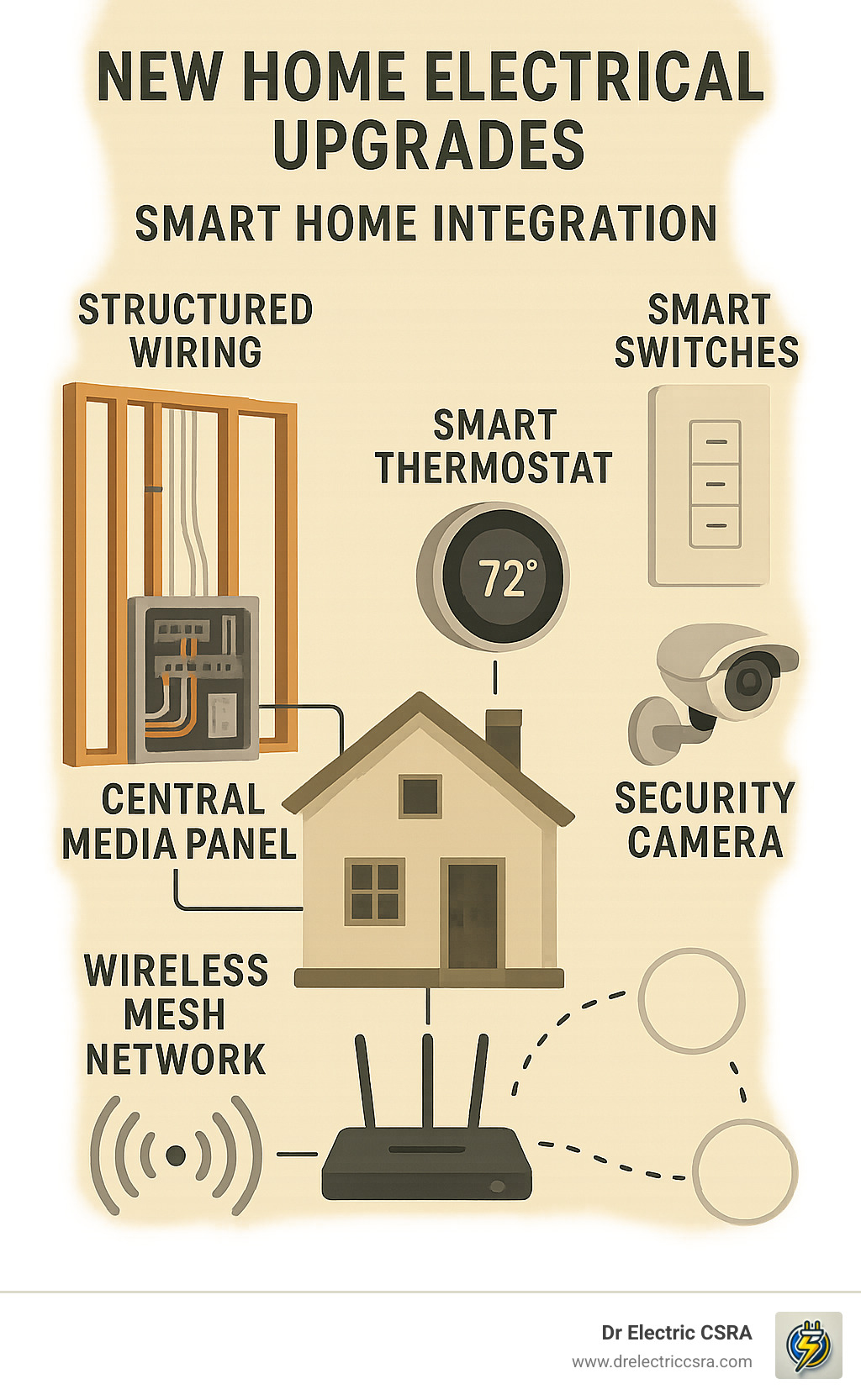
EV & Renewable Readiness
Electric vehicles aren’t coming someday – they’re here now, and your new home should be ready. Even if you’re not driving electric today, new home electrical upgrades that include EV preparation add serious value to your property.
Our Car Charger Installation service focuses on 240V Level-2 charging systems that can fully recharge most electric vehicles overnight. Installing this infrastructure during construction costs a fraction of retrofit work.
Solar conduit preparation costs almost nothing during construction but saves major money later. Running empty conduit from your roof area to your electrical panel gives you a clear path for future solar installation.
Generator interlock systems and proper battery backup preparation are becoming standard in smart home planning. The electrical infrastructure for these systems needs to be planned from the beginning.
Networking & Entertainment Backbone
Coax and fiber-optic lines provide the highway for ultra-high-speed internet and traditional cable services. Speaker wire pre-installed in main living areas and outdoor spaces lets you add distributed audio systems without tearing into finished walls later.
Home theater prewire includes both dedicated electrical circuits and low-voltage wiring for projectors, screens, and surround sound systems. Distributed audio systems can fill your entire home with music, but they require both power and signal wiring to multiple zones.
4. Light the Way: Modern Fixtures & Controls
Good lighting transforms a house into a home. When planning new home electrical upgrades, your lighting strategy deserves as much attention as your electrical panel.
LED recessed cans have revolutionized home lighting. These fixtures consume up to 90% less power than old incandescent bulbs and last decades longer. Install them throughout your home, but remember – they need compatible circuits and proper insulation ratings.
The magic happens when you pair those LEDs with dimmer controls. Modern LED dimmers eliminate that annoying flicker and let you set the perfect mood for any occasion. Install dimmers on all ceiling fixtures.
Occupancy sensors are incredibly practical. Walk into a closet or pantry, and the lights turn on automatically. Walk out, and they shut off. Daylight harvesting takes this concept further – smart lighting systems monitor natural light levels and adjust artificial lighting accordingly.
Under-cabinet strips in the kitchen provide excellent task lighting for food prep while creating warm ambiance for evening entertaining. Control them separately from overhead lights for maximum flexibility.
For safety with style, consider stair tread LEDs. These subtle lights guide your way without harsh overhead lighting – perfect for late-night trips to the kitchen.
Landscape lighting completes your home’s lighting story. Low-voltage outdoor systems improve security, highlight architectural features, and create beautiful curb appeal. Plan the electrical infrastructure during construction to avoid digging up finished landscaping later.
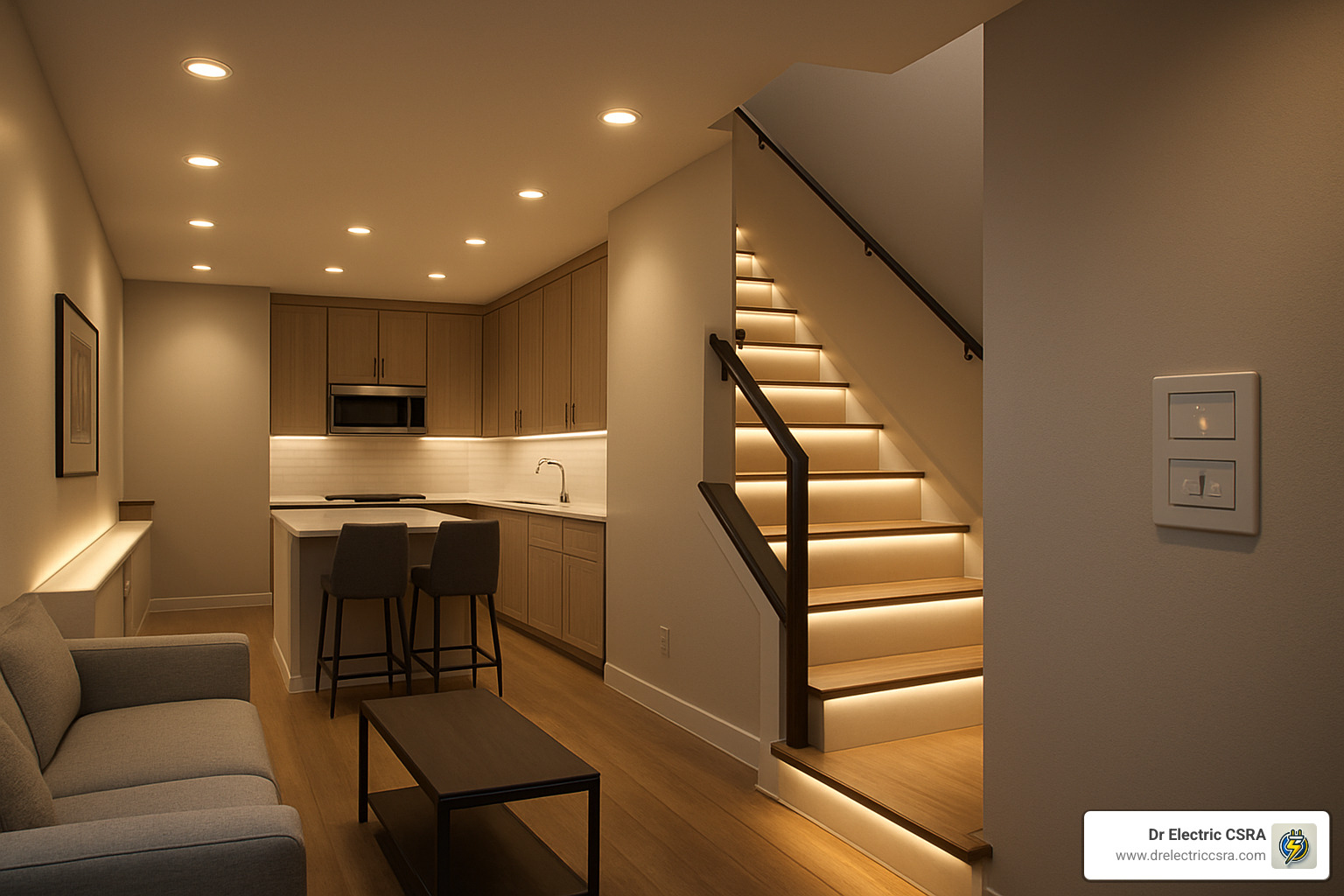
Designing Lighting Around New Home Electrical Upgrades
Think of lighting like seasoning in cooking – you need different types for different purposes. Task lighting handles the work – under-cabinet strips for chopping vegetables, desk lamps for reading. Ambient lighting provides general illumination through recessed cans or ceiling fixtures. Accent lighting adds visual interest with wall sconces or decorative fixtures.
Multi-way switching prevents that awkward stumble across dark rooms. Install three-way or four-way switches in rooms with multiple entrances.
Smart scenes represent the future of home lighting. Program different lighting combinations for various activities. “Movie Night” dims most lights while keeping pathway lighting active. “Dinner Party” creates warm, welcoming ambiance.
Color-tunable LEDs offer the ultimate in lighting flexibility. These advanced systems change color temperature throughout the day – warm, cozy light in the evening supports natural sleep patterns, while cooler, brighter light during the day improves alertness.
The key to successful lighting design is planning circuits that support flexibility. Install separate switches for different lighting zones in each room.
5. Safety & Efficiency Essentials
Safety should never be an afterthought in electrical planning. Modern safety devices and energy-efficient systems protect your family and your wallet.
Grounding Electrodes: Proper grounding protects against electrical shock and equipment damage. Modern homes require multiple grounding methods including ground rods and grounding electrode conductors.
Whole-House Surge Protection: Power strips can’t protect against major surges from lightning or utility issues. Whole-house surge protectors installed at your main panel provide comprehensive protection for around $300.
Smart Smoke/CO Detectors: Modern smart smoke alarms detect both smoke and carbon monoxide, provide faster alerts, and can notify you remotely. They also integrate with smart home systems for coordinated responses.
Energy Monitors: Track your home’s energy consumption in real-time through smartphone apps. These devices help identify energy waste and optimize usage patterns.
Insulation-Rated Fixtures: Recessed lights in insulated ceilings require IC-rated fixtures to prevent fire hazards.
Learn more about proper Electrical Grounding for Safety and why it’s crucial for your new home.
The AFCI fire-prevention study shows how arc-fault protection significantly reduces electrical fire risk.
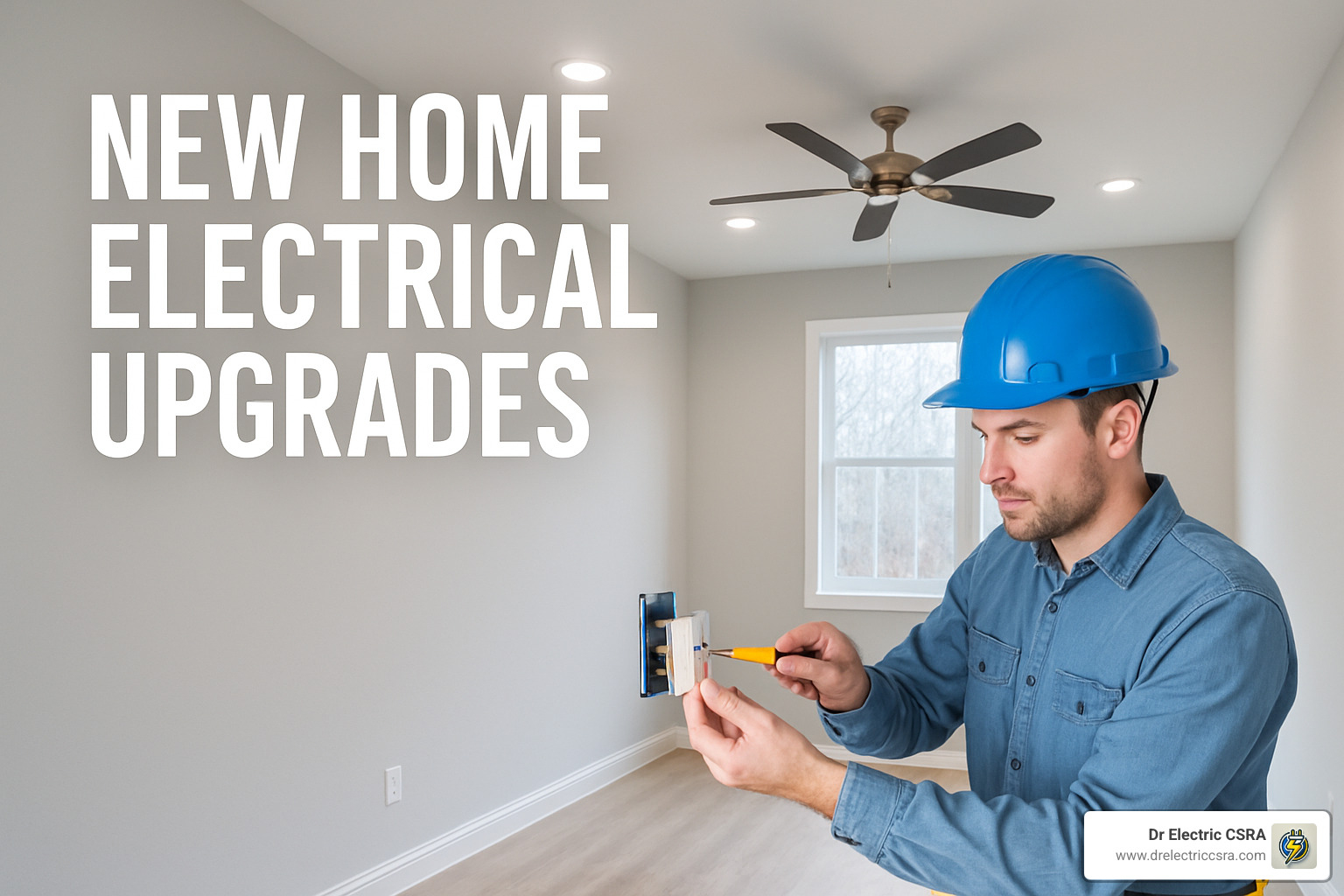
Code Compliance Checklist
NEC 2023 Highlights: The National Electrical Code updates every three years. Key requirements for new homes include:
– AFCI protection for most living spaces
– GFCI protection expanded to more areas
– Tamper-resistant receptacles throughout
– Proper labeling of all circuits
Permit & Inspection: All electrical work requires permits and inspections. Professional installation ensures code compliance and safety.
Energy-Smart Upgrades That Pay Back
LED Conversion: Converting all lighting to LED can reduce lighting energy consumption by 80% or more. The upfront cost pays for itself through reduced utility bills.
Smart Thermostats: Programmable and smart thermostats optimize heating and cooling schedules, potentially saving 10% annually on HVAC costs.
Ceiling Fans: Properly installed ceiling fans allow higher thermostat settings in summer and better air circulation in winter, reducing HVAC loads.
Standby Generator Integration: Whole-house generators provide peace of mind and can increase home value. Learn about Whole House Generators Prices Installed for your new home.
Frequently Asked Questions about New Home Electrical Upgrades
How many outlets should I plan per room?
The 12-foot rule from the National Electrical Code is just the starting point. Living rooms need outlets behind every seating area, plus floor outlets for table lamps. Bedrooms should have outlets on both sides of the bed. Kitchens require outlets every 4 feet along countertops, but add extras for small appliances.
Walk through each room and imagine your furniture placement. Every spot where you might plug in a lamp, charge a device, or use an appliance needs an outlet within easy reach. New home electrical upgrades during construction cost pennies compared to adding outlets later.
Do I really need a 240V garage circuit today?
Absolutely. Electric vehicles are becoming mainstream faster than most people realize. Even if you’re driving a gas car today, your next vehicle might plug in. A 240V, 50-amp circuit can charge an EV overnight instead of taking days with a regular outlet.
This circuit also powers welding equipment, electric car lifts, high-powered tools, and electric heaters. The installation during construction typically costs under $500. Retrofitting the same circuit after your garage is finished? Plan on spending $2,000 or more.
Hard-wired vs wireless: which is better for security & audio?
Wired systems win for reliability and performance. Security systems work better with hard-wired connections because they can’t be jammed, hacked, or affected by Wi-Fi dead zones. Audio systems sound noticeably better with wired connections, avoiding dropouts and interference.
The practical approach: install the wiring infrastructure during construction, then choose the best available technology when you’re ready to install equipment. Running speaker wire and security cable costs very little during the rough-in phase, giving you options for the future.
Conclusion

Getting new home electrical upgrades right the first time is like buying a good mattress – you won’t appreciate it until you need it, but when you do, you’ll be grateful every single day.
You’re building a home that needs to serve your family for decades. The electrical system you install today will power everything from your morning coffee maker to future technologies we haven’t even imagined yet.
Safety comes first, always. Every GFCI outlet, every properly grounded circuit, and every code-compliant installation protects the people you love most. But safety is just the foundation. The real magic happens when your electrical system makes daily life easier and more enjoyable.
Picture coming home to a house where every room has outlets exactly where you need them. Where your garage is ready for that electric vehicle you might buy in five years. Where your smart home systems work seamlessly because the infrastructure was planned from day one.
Convenience and resale value go hand in hand. Today’s luxury becomes tomorrow’s standard. The 240V garage outlet that seems unnecessary now will be a selling point when half the cars on the road are electric.
Here’s the truth about electrical work: it’s a one-and-done opportunity during construction. Adding circuits and outlets costs pennies on the dollar compared to retrofitting later. Once those walls close up, every electrical addition becomes a major project involving drywall repair, painting, and disruption to your daily life.
At Dr. Electric CSRA, we’ve guided countless homeowners through this process in Augusta, Evans, Grovetown, Martinez, Aiken, and North Augusta. We’ve seen the relief on faces when families realize their electrical system can handle everything they throw at it.
Your new home represents your family’s future. Don’t let inadequate electrical planning limit that potential. Whether you’re dreaming of a smart home paradise or simply want enough outlets to plug in your devices without hunting for extension cords, the time to plan is now.
Ready to power your new home the right way? Our team brings the expertise and local knowledge to make your electrical vision a reality. And once you’re settled in, our maintenance electrical services keep your investment running smoothly for years to come.
Your family deserves an electrical system that works as hard as you do. Let’s build it right, together.


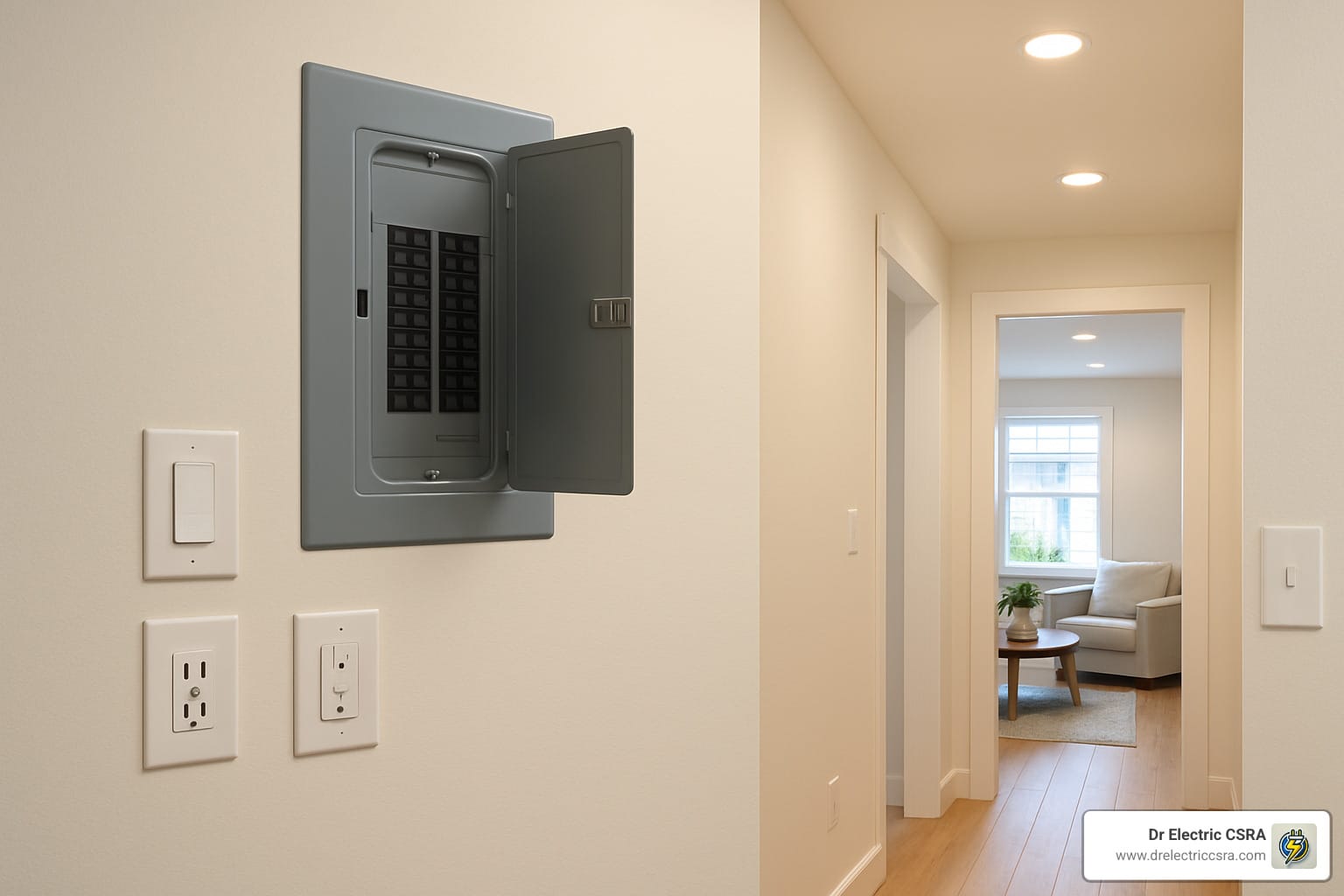



0 Comments